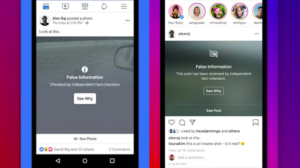
By Jonah Isaac and Sophie Dunn
The pictures above, flagging disinformation on social media, have become an all-too-common sight for many Americans. Social media usership is rising rapidly in tandem with the increasing proportion of adults who get their news from the various social media platforms. As a result, the prevalence and threat of information operations online has become undeniably clear.
But, the response to this issue has been anything but clear.
The confusing response to online information operations begins with the overlapping roles of various good actors, including social media companies, security-oriented government agencies, non-profit organizations, academia, and journalists. All of these different types of organizations have made impressive but insufficient strides to defeat the spread and threat of information operations online. Often, the objectives and responsibilities of these types of organizations overlap, as the different types of organizations take slightly different approaches to the same issue. The consequence of this overlap is an uncoordinated and inefficient approach to information operations mitigation governed by multiple protocols, ethical standards, and priorities.
The theme of an uncoordinated response to IO extends within the different classifications of actors.
Just as there is a lack of coordination between the different types of actors, similar issues pervade each individual type of actor. For one, the federal government has no well-defined, official protocol for responding to information operations nor a specific government agency designated as the counter-IO leader. In the federal government different agencies work to address the same problem, agencies including the Department of Justice, Defense Department, Department of State, and Department of Homeland Security. Yet there is no unifying body that ensures the organizations do not have overlapping tasks and responsibilities. With regard to the private social media corporations, each of the large platforms has their own standards and responses for disinformation and other problematic content. Journalists and media organizations do not tell the disinformation story in the same way, leading to conflicting narratives that confuse American news consumers.
If this weren’t bad enough, there is even inconsistency within the various units within the organizations responding to disinformation.
For example, in Facebook alone, there are at least six departments that deal with information operations. In the public sector, the Army’s Combatant Command has multiple directorates all also dealing with information operations, including the J2, J5, and J39. Examples like these go on and on.
Given all the different levels of obfuscated, uncoordinated, and redundant responses, what should be done?
The first step of mitigating the threat of IO will require two things: coordination and collaboration between both public and private actors. A coordinated mitigation effort should incorporate the main actors that are involved in both media and national security: social media companies, relevant government agencies, non-profit organizations, academia, and journalists. Coordination would ensure that the actors are not wasting their resources on rendant efforts and would also standardize the various principles that govern content moderation. Collaboration would allow for each entity to better execute their role by leveraging different strengths and resources by working together. Utilizing both coordination and collaboration simultaneously would establish the much-needed platform from which to establish protocols, ethical standards, and priorities.
This proposal begs the question of how to organize such an array of actors.
One way to do so would be to create a Media and Information Liaison Office (MILO), which could be housed in the Cybersecurity and Infrastructure Security Agency (CISA) or the NSA’s Cyber Command. MILO would act as the platform from which public and private entities would jointly counter IO. One of the most central functions of MILO would be to establish a thorough and repeatable procedure that identifies disinformation, shares data across organizations, flags disinformation, and raises awareness of the threat in public discourse.
Incorporating academia, non-profit organizations, and journalists augments the sustainability and strength of this effort. Academics would bring a forward-thinking perspective that would provide the partnership with proactive capabilities as well as a well-researched understanding of IO. Non-profit organizations would be able to use their versatile positions to spread awareness and offer resources to increase cyberspace resiliency among vulnerable populations. Finally, journalists would provide the crucial connection between the public and the partnership, providing verified facts when reporting on an issue.
Opposition to similar partnerships is often based on the idea that the group would attempt to become an arbiter of truth. However, the basis of MILO is collaborative verification. Through such large-scale collaboration the body avoids leaning towards subjectivity. Therefore, the partnership would not only enhance the national security effort to counter IO, it would maintain and secure the foundational right of freedom of speech.
In all, the various actors above will need to increase their collaboration and coordination if they wish to truly defeat the threat of IO and this might just be the best way for them to do so.


